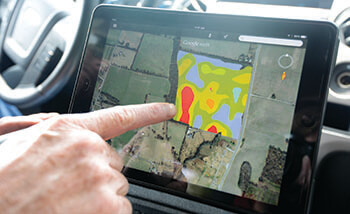Fine-tuning Fertilizer Prescriptions with Multiple Yield Goals
Feb 03, 2020

As soil sample results begin to roll in, it’s time to start analyzing the data to set yield goals for spring fertilizer applications. Whether you use variable or traditional flat rate applications, it’s important to set a yield goal and determine fertilizer amounts. Two questions to ask are “What yields am I trying to achieve in this field?” and “What nutrient removal will occur with that goal?”
Basic fertilizer rates are configured using an equation typically consisting of two parts: 1) a maintenance portion or the amount of fertilizer needed for this year’s crop, and 2) a build portion or the amount of fertilizer needed to raise soil nutrient levels to a desired level across a set number of years.
Consider enhancing your fertilizer prescriptions by developing multiple yield goals within each management zone. By grid or zone sampling, soil nutrient variability is accounted for across the field, and the same can be done with field yield goals.
Yield maps, when calibrated and cleaned, can paint a picture of the field’s future performance, and a realistic yield goal can be assigned by analyzing factors such as soil type, nutrient-holding capacity, and topography.
A normalized yield map can help increase the accuracy of these goals. When multiple years of yield data are available, these maps can be stacked together to show a true trend of a field’s year-to-year performance. For farmers without yield monitors, in-season imagery — from the time of peak biomass in late July or August — can be used to gauge yielding potential, especially if a field average is known. Imagery is available through Incompass or WinField United’s R7 Tool.
Once management zones are created, assigning yield goals is only the beginning. They can also help to shape planting decisions and hybrid selection and placement. With the use of a variable-rate planter, populations can be adjusted higher or lower to reflect the yielding potential of that ground.
Multi-hybrid planting is another option. Some hybrids perform better in stressful environments, and placing these hybrids in the lower yielding areas can help mitigate that stress. On the flipside, the historically high yielding areas can be pushed by placing a “racehorse” hybrid to max that potential.
Talk with your local Co-op agronomist on how to get started making in-depth management zones to fine-tune your fertilizer and seeding prescriptions.
Basic fertilizer rates are configured using an equation typically consisting of two parts: 1) a maintenance portion or the amount of fertilizer needed for this year’s crop, and 2) a build portion or the amount of fertilizer needed to raise soil nutrient levels to a desired level across a set number of years.
Consider enhancing your fertilizer prescriptions by developing multiple yield goals within each management zone. By grid or zone sampling, soil nutrient variability is accounted for across the field, and the same can be done with field yield goals.
Yield maps, when calibrated and cleaned, can paint a picture of the field’s future performance, and a realistic yield goal can be assigned by analyzing factors such as soil type, nutrient-holding capacity, and topography.
A normalized yield map can help increase the accuracy of these goals. When multiple years of yield data are available, these maps can be stacked together to show a true trend of a field’s year-to-year performance. For farmers without yield monitors, in-season imagery — from the time of peak biomass in late July or August — can be used to gauge yielding potential, especially if a field average is known. Imagery is available through Incompass or WinField United’s R7 Tool.
Once management zones are created, assigning yield goals is only the beginning. They can also help to shape planting decisions and hybrid selection and placement. With the use of a variable-rate planter, populations can be adjusted higher or lower to reflect the yielding potential of that ground.
Multi-hybrid planting is another option. Some hybrids perform better in stressful environments, and placing these hybrids in the lower yielding areas can help mitigate that stress. On the flipside, the historically high yielding areas can be pushed by placing a “racehorse” hybrid to max that potential.
Talk with your local Co-op agronomist on how to get started making in-depth management zones to fine-tune your fertilizer and seeding prescriptions.